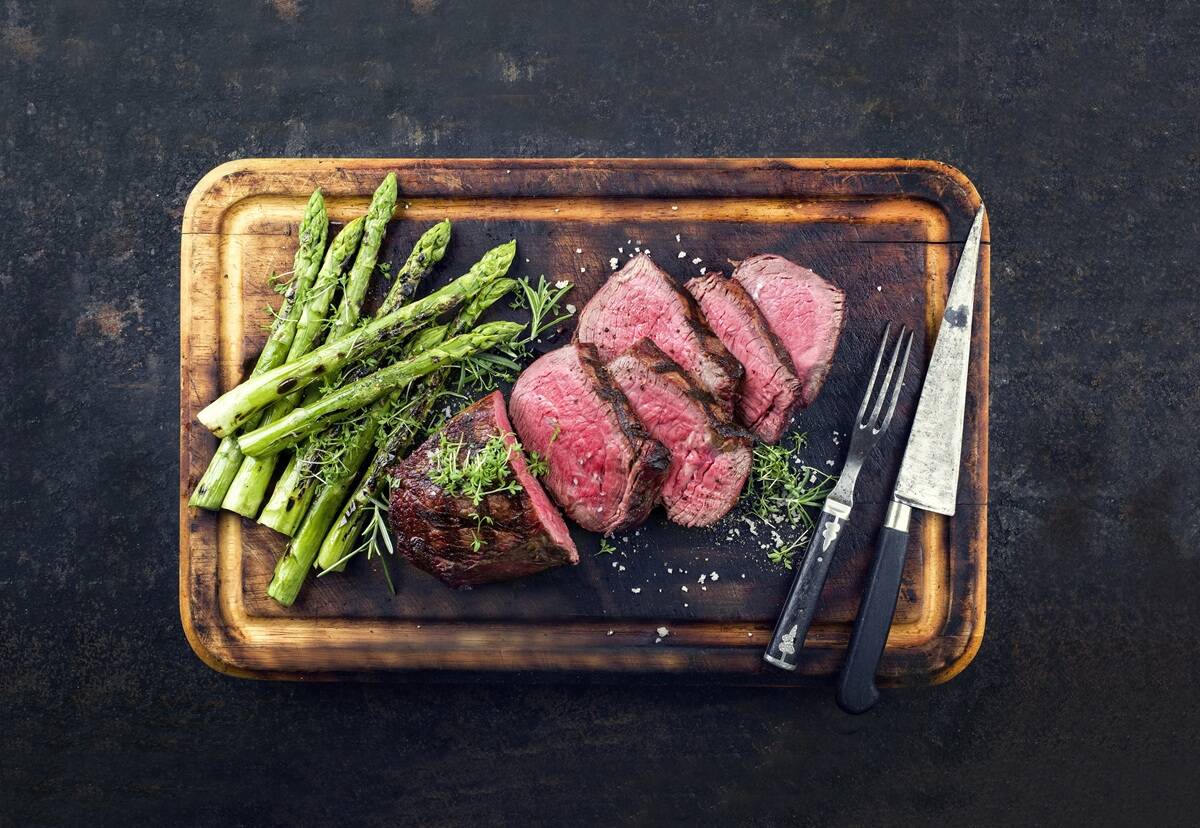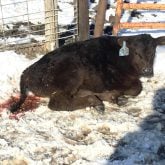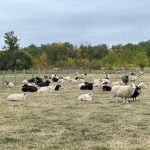Andreas Scheurer knows his cattle slaughter process is not for everyone.
The fourth-generation farmer raises a small herd of Aubrac cows for direct sale from his farm in Kallnach, Switzerland, and works as a full-time agronomist at the School of Agricultural, Forest and Food Sciences in Zollikofen.
His focus is giving his cows the best life and as stress-free a death as he can, but that comes at a cost. Given the labour, equipment rental needs and the schedule at the local processor, Scheurer said one animal a week from his small herd is as much as his small-scale operation can handle.
Read Also

Building demand together: The impact of Canada’s beef import levy
The beef import levy has become a central tool for ensuring balance in Canada’s beef industry
On his 48-acre farm in central Switzerland, Scheurer’s 12 suckler cows and calves are left to graze together on grass and hay in Scheurer’s own pasture land. Another 30 acres are dedicated to arable crops with grass and hay in rotation with crops for human consumption, such as wheat, sunflowers, spelt and carrots.
Since changing his focus to more humane practices on his farm, Scheurer’s mental health has also improved as his operation developed. He was always really stressed when they used to haul animals off-farm to be slaughtered and processed.
“I didn’t sleep well the night before, and now we slaughtered one this morning, and last night, I slept very, very well.”
His humane practices start long before the animals are processed into 10-kilogram mixed packs sold directly to his local consumers.

Animals are moved between the pasture and the barn nearly every night, said Scheurer, which reduces stress when they are brought in for slaughter since it doesn’t introduce a change in routine. Everything is familiar to them on the farm, he said, as they stay in the same herd throughout their lives. Scheurer makes sure the cows never feel alone, even after they are separated before the slaughter.
“From birth, they are always in this herd. So when they are separated, they don’t feel so good. But when the others are around, they cannot go to them, but they (other cows) are around, they (the isolated cow) can see them.”
One animal is brought into the barn on a Monday evening, fed and watered through Tuesday and Wednesday, and then they are stunned and drained on Thursday morning. They then have 90 minutes to get the animal to the processor. Farmers need a license from a regional veterinary office to slaughter on their own farms and they must be located within a 20-minute drive of a processor. Scheurer said they live even closer so luckily they can get there in two minutes.
Scheurer has a lot of visitors to his farm, including students and colleagues, and he is always discussing better ways to work with his cattle. It’s always a process and there is always something to optimize, he said. Even with on-farm help from his parents and partner, he has found the maximum he can slaughter is one cow a week, since his barn can only fit one animal at a time. The most he could optimize is his pace management and changing the floors to be safer when it gets wet, he said, but for the other side of the farm, Scheurer is finding it challenging to find the right grass varieties, especially ones that grow better in droughts.
“We have to change the spots with clover and grass. When you have a very dry summer, and there is no grass outside, I have to find other grasses that grow well when it’s dry and hot.”
Scheurer admits that it would be impossible for large Swiss cattle lots to slaughter their animals using his system, but federal animal protection regulations are still quite strict. There could be better ways for bigger operations to optimize how animals are treated throughout their lives, such as more grazing time on pasture land, but for the slaughtering process, Scheurer knows they are doing their best.
“The animals are stressed, it’s an environment they don’t know. But the people there are really calm and it’s very easy for the animals to go in. In this big style to slaughter animals, it’s the best we can do.”
While Sarah Hunt’s Farmersville Community Abattoir in Athens, Ont., is not as small as Scheurer’s, by Canadian standards they are small-scale and local, with a focus on humane slaughter.
During their busiest times of year in the fall, they aim for 12-15 beef cattle a week and another 15 pigs, goats and sheep, but the goal is still the same: give the animal a calm experience before their “one bad minute.”
There is still a moment of consternation for Hunt. The tough part of the job is being the one to pull the trigger on the retractable stun bolt pistol, she said, and she admits she is a “crier by nature.” It takes a special person to do the job and the workers have to be able to disassociate and not dwell on the doom and gloom of it all.
“It’s work, it’s not personal,” said Hunt. “As long as the humane aspect is taken care of and the animal is handled respectfully, the rest of it seems to come together.”
Ten per cent of the animals they process come from the family’s own Limousin cattle herd with Hunt’s husband’s family raising cattle since the 1960s. Especially with those animals coming through the chute, Hunt knows the animal had a good life before death. With the shot being instantaneous, she knows the animal doesn’t feel any pain before it happens.
“I don’t think that they know what is going on at all. They just know that they’re in an unfamiliar place… As long as I’m conscious that I’ve done my part in treating them as well as they possibly can be in the short time that they’re with us, I can sleep at night.”
Neither Scheurer nor Hunt notice a change in the quality of the beef using these more humane methods; meat quality is far from the biggest driver for their humane practices. But recent studies do show that keeping animals calm can reduce such things as bruising, hyperglycemia and high levels of cortisol in the final cuts.
A recent paper published by the Asian-Australasian Journal of Animal Sciences looked at federal inspection-type slaughterhouses located in the southeast of Mexico. Post-mortem bruising resulted from improper handling of steers during transport and slaughter, and things like “pH, tenderness, aging potential, colour and water-holding capacity” made for low-quality meat described as dark, firm, and dry meat.
According to the 2023 agricultural report produced by the Swiss government’s agricultural and economic affairs departments, most Swiss consumers prefer local products; in terms of Swiss beef, 58 per cent of respondents noted a local preference. Shorter transportation routes, support for domestic agriculture and high-quality products were the reasons cited in the report.
Even working in the abattoir, humane slaughter is not a frequent conversation Hunt needs to have with her customers, she said. Whether that is through the abattoir’s well-known reputation for treating their animals humanely or consumer indifference to humane practices, she doesn’t know.
While it takes more work on his part to work with the animals, it has been worth it for both Scheurer and his consumers, who know about his organic, stress-free cattle. People like this, he said, and this is the main reason they purchase beef from him.
“They didn’t have stress. They weren’t stressed when they were killed, and they were easy (and) calm. This is the reason why the people want the beef from my cattle.”
According to the Swiss Confederation, around 48,000 farms average 54 acres in the small European country. While the total number of farms has continually decreased since 1996, the number of agribusinesses with over 74 acres is on the rise.
Half of the agricultural sector’s revenue is generated through livestock farming, but federal support plays a huge role in keeping farms going. The Swiss government’s direct payments to the agricultural industry ensure operations are financially sustainable but many farmers have a second job off the farm. Under Article 104 of Switzerland’s constitution, farmers receive government funding for agricultural practices that provide food security, conserve natural resources, manage the landscape, and promote near-natural production with methods that respect both the environment and livestock. In 2023, the Swiss government directed the equivalent of over $5.5 billion CAD to agriculture, adding up to 7.5 per cent of its total subsidies.
– Becky Zimmer is a freelance journalist based in Humboldt, Sask. Her farming and small-town background have given her a passion for Prairie journalism, provincial and national government policies, civic politics, community events and the challenges of rural healthcare and infrastructure.
















